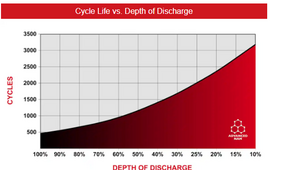As
@MiSh says, the battery charts look like this:

235*.6
I don't think you'll find an actual formula that at 700 cycles and half way through the 1400 cycle lifecycle, at 40% DOD, how many amp hours are left at that 700 th cycle.
I do think that 40% loss f battery capacity is a bit unusual, but perhaps on the low end of a margin of error.
With that, a 235 ah lead acid batteries like to get charged at 25-30 amps, and if its much lower than that, that will shorten the life. Also if its higher than 30 amps, that could exceed the max xharge rate of the batteries. Without any guidance, they should not be charged at more than 10% of amp hour rating. My FLA Trojan's had a 13% of the 20 hour rate to charge. I've seen AGMs anywhere form 10% to 30% the 20 hour charge rate.
I upgraded from Lead Acid to Lithium in part because I found the sun light was not regular enough to charge at the 13% rate of my battery. I found myself at the point where I could exceed that 13%, which in my case was 60 amps. My batteries would be charged before the sun was up high enough to put 60 amps into them, but then a cloudy day could happen and the clouds would break at lunch, and my MPPTs could push more than 60 amps into the batteries, or after charge was complete, I could turn on a high power load, and for couple of minutes, the panels could push 72 amps back into the batteries.
I got the lithoums right after I starte to get the capacity to overcharge the batteries.



